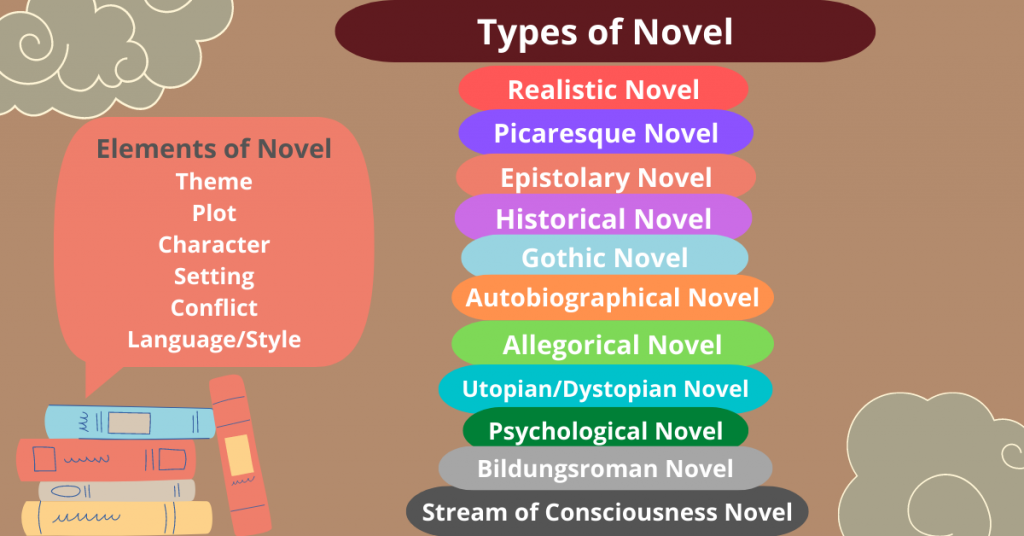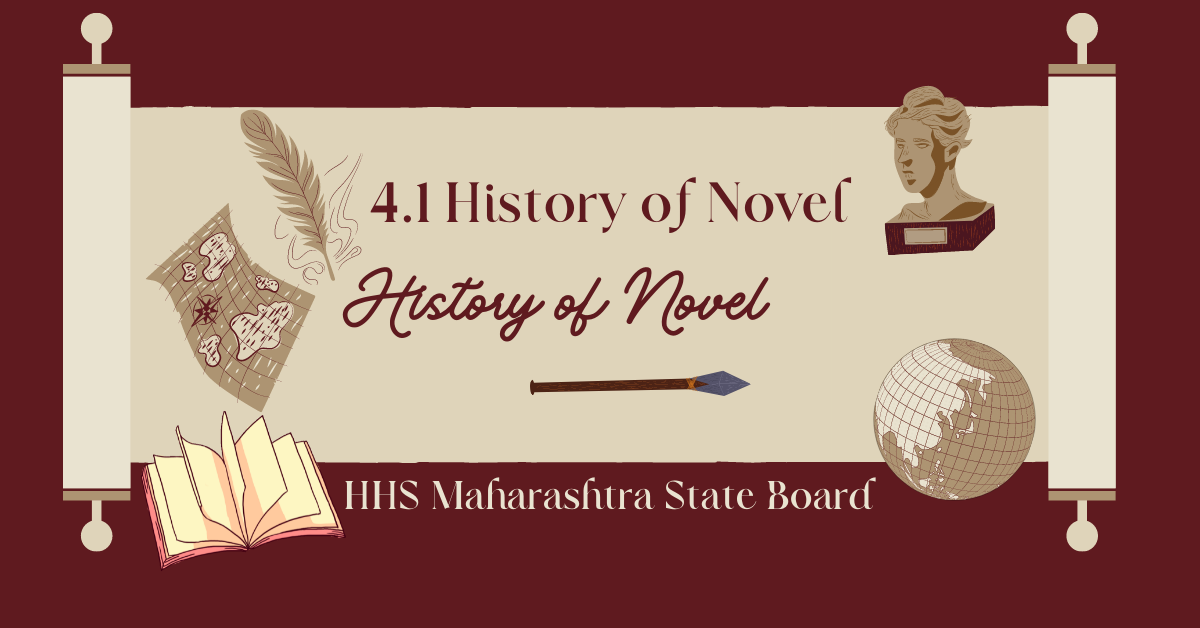Dear students the Maharashtra State Board included the history of Novel in section no.4 in your Syllabus of English Subject, For the purpose of that, the Students know the literary genre Novel and its history. 4.1 History of Novel will be asked for 4 marks in your H.S.C. Board Activity Sheet section 4. So this point 4.1 History of Novel is important for your study.
How activities will come, on section 4.1 History of Novel:
- It’s more important to learn about how activities (Question& answers) will come to solve in section 4.1 History of Novel. On 4.1 History of Novel the activities will be as follows:
1. Activities on History of Novel – 2 marks
2. Activities on History of Novel – 2 marks
- Activities should be framed on MCQ/ Match the column/ Chronological order/ Fill in the blanks/True false/ Elements of Novel OR any other novel activities
- (Activities should not be repeated in sub-questions)
Let’s learn how the activities will come in your paper:
A.1. choose the correct alternative and rewrite the sentence:
- The eighteenth century has gifted English literature with two entirely new forms………
a)Drama and poetry, b) novel and drama, c) The periodical essay and Novel, d) poetry and the periodical essay
Ans. c) The periodical essay and Novel
- The present English ward Novel is derived from…..
a) Spanish, b) Irish, c) French, d) Italian
Ans. D) Italian
- The novel makes life easier to understand than in……
a) Poetry, b) drama, c) both poetry and drama, d) one-act play
Ans.c) both poetry and drama
- The novel as a literary genre has a history of about ………
a) One thousand years, b) Two thousand years, c) Three thousand years, d) Four thousand years
Ans.b) Two thousand years
- Murasaki Shikibu’s ‘Tale of Genji’ has been described as ………
a) The world’s first novel, b) The world’s second novel, c) The world’s third novel, d) The world’s fourth novel
Ans,b)The world’s first novel
- The European novel is often said to begin with…………
a) Don Quixote, b) Tale of Genji, c) the Canterbury tales, d) Gulliver’s tales
Ans. a) Don Quixote
- The novel ‘Don Quixote’ was published in two parts between ………..
a) 1604 and 1610, b) 1605 and 1615, c) 1605 and 1610, d) 1608 and 1615
Ans. b) 1605 and 1615
- In the 18th century, a large number of readers from the middle class were attracted in the appearance of………..
a) Drama and Poetry, b) Poetry and Magazines, c) Newspaper and Magazines, d) Newspaper and Drama
Ans. c) Newspaper and Magazines
- The eighteenth century has gifted English literature with two entirely new forms………
a)Drama and poetry, b) novel and drama, c) The periodical essay and Novel, d) poetry and the periodical essay
Ans. c) The periodical essay and Novel
- The present English ward Novel is derived from…………
a) Spanish, b) Irish, c) French, d) Italian
Ans. D) Italian
- The novel makes life easier to understand than in………..
a) Poetry, b) drama, c) both poetry and drama, d) one-act play
Ans.c) both poetry and drama
- The novel as a literary genre has a history of about …………
a) One thousand years, b) Two thousand years, c) Three thousand years, d) Four thousand years
Ans.b) Two thousand years
- Murasaki Shikibu’s ‘Tale of Genji’ has been described as ………….
a) The world’s first novel, b) The world’s second novel, c) The world’s third novel, d) The world’s fourth novel
Ans. b) The world’s first novel
- The European novel is often said to begin with………….
a) Don Quixote, b) Tale of Genji, c) the Canterbury tales, d) Gulliver’s tales
Ans. a) Don Quixote
- The novel ‘Don Quixote’ was published in two parts between ………..
a) 1604 and 1610, b) 1605 and 1615, c) 1605 and 1610, d) 1608 and 1615
Ans. b) 1605 and 1615
- In the 18th century, a large number of readers from the middle class were attracted in the appearance of………..
a) Drama and Poetry, b)Poetry and Magazines, c)Newspaper and Magazines, d) Newspaper and Drama
Ans. c) Newspaper and Magazines
- In the 18th century, the Novel as a form appears to have been designed for both to voice the aspirations of…………..
a)Middle and Lower class, b) upper and lower class, c) middle and upper class, d) only lower class
Ans. a) Middle and Lower class
- The two types of conflicts that the plot may have are…………
a)Internal and opposite, b) internal and external, c) external and outside, d) internal and behavior.
Ans. b) internal and external
- The plot may be…………..
a) Only Simple (one plot), b) only complex, c) simple(one plot) or complex, d) None of the these
Ans. c) simple (one plot) or complex
- A novel based on Science of the age ‘Frankenstein’ by………..
a) Ann Radcliffe, b) Mary Shelley, c) Jane Austen, d) Frances Burney
Ans. b) Mary Shelley
- The novel of manners ‘Evelina’ by ………….
a) Ann Radcliffe, b) Mary Shelley, c) Jane Austen, d) Frances Burney
Ans. d) Frances Burney
- The word ‘picaresque’ originated from………….
a) Spanish, b) French, c) Greek, d) English
Ans. a) Spanish
- The word ‘epistolary’ derives from the…………
a) French, b) Latin, c) Italian, d) Spanish
Ans. b) Latin
A.2 Pick out the odd element from the following:
- Arun joshi, Vikram Seth, Graham Green, Kiran Nagarkar
Ans. Graham Green
- Place, Period, Theme, Climate, Lifestyle
Ans. Theme
- Theme, Plot, Novella, Character
Ans. Novella
- Jane Austen, Mary Shelley, Anita Desai, Frances Burney
Ans. Anita Desai
- Anita Desai, Arvind Adiga, Mary Shelley, Kiran Nargrkar
Ans. Mary Shelley
- Mulkraj Anand, R.K. Narayan, Raja Rao, Kiran Deasi
Ans. Kiran Desai
- E.M. Forster, Joseph Conrad, Virgil, Henry James
Ans. Virgil
- Novelists of the 18th century are Samuel Richardson, Henry Fielding, Lawrence Sterne, George Orwell
Ans. George Orwell
- Salman Rushdie, V.S. Naipaul, Kazuo Ishiguro, William Golding
Ans. William Golding
- Canterbury Tales, Ecologues, Rajamohan’s Wife, The Pilgrim’s Progress
Ans. Rajamohan’s Wife
A.3 Identifies whether the following statements are true or false.
- ‘Don Quixote’ has been described as the world’s novel.
Ans. False
- ‘Tale of Genji’ has been described as the world’s first novel.
Ans. True
- The present English word is derived from the Spanish Language.
Ans.False
- The present English word is derived from the Italian Language.
Ans.True
- The novel Tale of Genji is written by Murasaki Shikibu.
Ans. True
- The novel ‘Don Quixote’ is written by Spanish writer Miguel de Cervantes.
Ans. True
- In the 18th century, the appearance of newspapers and magazines attracted a large number of readers from the Upper Class.
Ans. False
- In the 18th century, the appearance of newspapers and magazines attracted a large number of readers from the Middle Class.
Ans. True
- There are six elements essential to the novel.
Ans. True
- The plot may be only simple (one plot).
Ans. False
- The plot may be simple (one plot) or complex.
Ans. True
- The readers follow the actions of one main character throughout the novel, it is called the protagonist.
Ans. True
- The opposite forces in the story are called ‘conflict’.
Ans. True
- The word ‘picaresque’ originated from the Italian word.
Ans. False
- The word ‘picaresque’ originated from the Spanish word ‘picaro’.
Ans. True
- The word ‘epistolary derives from the Latin word ‘Epistola’.
Ans. True
- A realistic novel is a fiction based on realism.
Ans. True
- The setting is the background in which the story takes place.
Ans. True
A. 4 Fill in the blanks
- The eighteenth century has gifted two new from………. and …………
a) Drama and poetry, b) novel and drama, c) The periodical essay and Novel, d) poetry and the periodical essay
Ans. c) The periodical essay and Novel
- The present English word is derived from…………. meaning………..
a) Spanish, beginning b) Irish, start c) French, middle d) Italian, new
Ans. d) Italian, new
- Murasaki Shikibu’s……………….. has been described as The world’s first novel.
a) ‘Tale of Genji’, b) Don Quixote, c) Seize The Day, d) The Heart of Darkness
Ans. a) ‘Tale of Genji’
- The European novel is often said to begin with ……….. by Miguel de Cervantes
a) Don Quixote, b) Tale of Genji, c) the Canterbury tales, d) Gulliver’s tales
Ans. a) Don Quixote
- …………….novel is written by John Bunyan.
a) Tale of Genji, b) Oroonoku, c) The pilgrim’s Progress, d) Don Quixote
Ans. c) The pilgrim’s Progress
- A famous satire …………… is written by Jonathan Swift.
a) Tale of Genji, b) Gulliver’s Travels, c) The pilgrim’s Progress, d) Don Quixote
Ans. b) Gulliver’s Travels
- The novel of manners ………is written by Frances Burney.
a) Frankenstein, b) the Wuthering Heights, c) Evelina, d) Death of Venice
Ans. c) Evelina
- ………….. is the pioneer of the Stream of Consciousness technique in the English novel.
a) Virginia Woolf, b) Frances Burney, c) Marry Shelley, d) Joseph Conrad
Ans. a) Virginia Woolf
- ……………is the first Indian English novel written by Bakim Chandra Chattopadhyay.
a) Rajamohan’s Wife, b) The Guide, c) The pilgrim’s Progress, d) Don Quixote
Ans. a) Rajamohan’s Wife
- ……..is essentially the story or the course of events that make up the theme.
a) Setting, b) Plot, c) Conflict, d) Character
Ans. a) Setting

A.5 Match the pairs:
Match the pairs of writers with their work
| Column ‘A’ Writers | Column ‘B’ Writer’s Work |
| 1.Murasaki Shikibu | a) Gulliver’s Travels |
| 2.Miguel de Cervantes | b) Oroonoku |
| 3.John Bunyan | c) Tale of Genji |
| 4.Aphra Behn | d) Don Quixote |
| 5.Daniel Defoe | e) The pilgrim’s Progress |
| 6.Jonathan Swift | f) Robinson Crusoe/Mall Flanders |
| 7.Samuel Richardson | g) Frankenstein |
| 8.Frances Burney | h) the Wuthering Heights / Jane Eyre |
| 9.Marry Shelley | i) Pamela/Clarissa |
| 10.Bronte Sisters Emily & Charlotte | j) Evelina |
| 11.Bakim Chandra Chattopadhyaya | k) Billy Budd |
| 12.Joseph Conrad | l) The Turn of the Screw |
| 13. Henry James | m) Rajmohan’s Wife |
| 14. Herman Melville | n) The Heart of Darkness |
| 15. Thomas Mann | o) Pearl |
| 16. Saul Bellow | p) Death of Venice |
| 17. John Steinbeck | q) Seize The Day |
Answers: 1 – b, 2 – d, 3 – e, 4 – b, 5 – f, 6 – a, 7- I, 8 – j, 9 – g, 10 – h, 11- m, 12- n, 13 – l, 14 -k, 15 – p, 16 – q, 17- o.
You may also learn about A Midsummer-Night’s Dream by William Shakespeare







